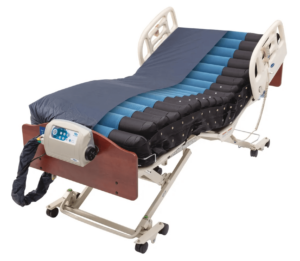Medicare Documentation Guide: Group 2 Support Surfaces

Quick Facts
- Low Airloss Mattresses now require prior authorization
- The process takes 5-10 days
- Wound care notes are very important for approval
Understanding Coverage, Documentation, and Authorization Requirements
Important Notice About Support Surfaces
Support surfaces are specialized pressure-redistributing devices designed to prevent or treat pressure injuries. While these surfaces (including low air loss mattresses) are commonly used in hospitals for both prevention and treatment, Medicare coverage in the home setting is much more limited and specific. It’s crucial to understand these differences when planning patient discharges or making referrals.
A common misconception is that low air loss mattresses can be ordered for preventative use at home, similar to hospital practice. However, Medicare will only cover Group 2 support surfaces (including low air loss mattresses) in the home setting when treating existing qualifying pressure ulcers or following specific surgical interventions as outlined in this guide. Preventative use, regardless of risk level, is not a covered indication.
Additionally, all Group 2 support surfaces(low airloss mattresses) now require Prior Authorization before delivery. This process typically takes 5-7 business days, sometimes longer if additional documentation is needed.
When planning discharges, it’s essential to:
Start the authorization process well before the planned discharge date
Submit all relevant wound care documentation, including measurements and staging
Include documentation of previous treatments and their outcomes
Provide clear evidence of medical necessity based on Medicare criteria
This guide will help you understand the specific coverage criteria, documentation requirements, and authorization process to ensure your patients receive appropriate coverage when medically necessary.
Basic Coverage Requirements
To qualify for a Group 2 support surface, your patient must meet ONE of these three criteria:
- Multiple Stage II Pressure Ulcers on Trunk/Pelvis
- Must have failed to improve over past month
- Must document ALL elements of comprehensive treatment:
- Use of appropriate Group 1 surface
- Regular wound assessments
- Turning/positioning program
- Wound care
- Moisture management
- Nutritional assessment and intervention
- Large or Multiple Stage III/IV Pressure Ulcers on Trunk/Pelvis
- No prior treatment requirement
- Must document location and staging
- Recent Myocutaneous Flap or Skin Graft
- Surgery within past 60 days
- Must have been on Group 2 or 3 surface before discharge
- Must be within 30 days of hospital/facility discharge
Special Section: Low Air Loss Mattresses (E0277)
What Qualifies as a Low Air Loss Mattress
Must have ALL features:
- Air pump/blower providing either sequential inflation/deflation OR low interface pressure
- Air cell height ≥5 inches
- Design that prevents “bottoming out”
- Surface designed to reduce friction/shear
- Can be placed directly on hospital bed frame
Documentation Requirements for Low Air Loss
- Initial Order Must Include:
- Specific type of surface (low air loss)
- Duration of need
- Frequency of use (usually continuous)
- Treating practitioner’s signature and date
- Clinical Documentation Must Show:
- Qualifying condition (from criteria above)
- Why lower group surface is insufficient
- Regular wound assessments
- Other interventions being used
Prior Authorization Process for Low Air Loss
- Submit:
- Detailed written order
- Clinical notes documenting qualifying criteria
- Wound measurements/staging
- Previous treatments and responses
- Photos if available (though not required)
- Timeline:
- Submit PA request before delivery
- Include most recent wound assessment (within past week)
- Document any failed Group 1 surface use
- Common PA Denials to Avoid:
- Missing comprehensive treatment program documentation
- Insufficient evidence of Group 1 failure
- Unclear wound measurements/staging
- Missing regular assessments
Required Documentation Elements
- Initial Assessment Note Must Include:
- Pressure ulcer locations
- Precise staging
- Wound measurements
- Previous treatments
- Current wound care plan
- Nutritional status
- Mobility assessment
- Ongoing Documentation:
- Weekly wound assessments
- Response to treatment
- Any changes in care plan
- Continued medical necessity
Key Documentation Tips
Group II Coverage
- Staging Documentation
- Use current NPUAP staging criteria
- Document specific anatomical locations
- Include wound measurements (length, width, depth)
- Note undermining/tunneling if present
- Treatment Program
- Detail ALL interventions
- Document patient/caregiver education
- Note any barriers to healing
- Include compliance information
- Monthly Assessments
- Document wound progress
- Note any new wounds
- Update treatment plan as needed
- Confirm continued need for surface
Common Documentation Errors to Avoid
- Missing Elements
- Incomplete wound measurements
- Missing staging information
- Unclear anatomical locations
- Incomplete treatment history
- Timeline Issues
- Late documentation of assessments
- Missing regular follow-up notes
- Gaps in wound care documentation
- Delayed response to complications
- Treatment Plan Gaps
- Missing comprehensive approach
- Insufficient detail on interventions
- Poor documentation of patient education
- Lack of nutritional assessment
Practical Documentation Workflow
- Initial Order:
- Complete face-to-face evaluation
- Document qualifying criteria
- Order appropriate surface
- Begin comprehensive treatment plan
- Weekly Documentation:
- Assess wounds
- Update measurements
- Note treatment response
- Document compliance
- Monthly Review:
- Evaluate progress
- Update care plan
- Document continued need
- Address any complications
- Discontinuation:
- Document wound healing
- Note date of discontinuation
- Provide follow-up plan
- Update referring providers
Quality Assurance Checklist
- Qualifying criteria clearly documented
- Comprehensive treatment plan in place
- Regular wound assessments completed
- Proper staging documented
- Treatment response noted
- Continued medical necessity verified
- Patient education documented
- Regular practitioner oversight confirmed
